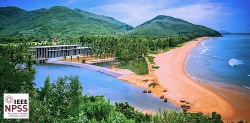Speaker
Description
Pulse pile-up poses an issue in the study of nuclear reactions and spectroscopy, arising when two pulses overlap, distorting data and compromising the accuracy of energy and timing details. Various digital and analogue techniques have been used to deal with pile-up interference. However, some pile-up events may include interesting pulses that require reconstruction.
This study introduces a novel approach to reconstructing pile-up events acquired using the Neutron Detector Array (NEDA), employing an Autoencoder based on a Convolutional Neural Network (CNN). The training and testing datasets for the Autoencoder have been created from NEDA data.
This new pile-up signal reconstruction method has been evaluated considering the similarity between reconstructed signals and the originals. Furthermore, it has been analysed from the point of view of Charge Comparison (C.C.), comparing the result obtained from original and reconstructed signals. The results of the analysis showcased a high similarity between the original and reconstructed signals, with an average correlation of 0.988, and 85.53% success in identifying particles post-reconstruction. This technique holds promise in mitigating adverse effects of pulse pile-up, salvaging previously discarded valuable information, and empowering future high-count-rate nuclear reaction and nuclear spectroscopy studies.
| Minioral | Yes |
|---|---|
| IEEE Member | No |
| Are you a student? | Yes |

